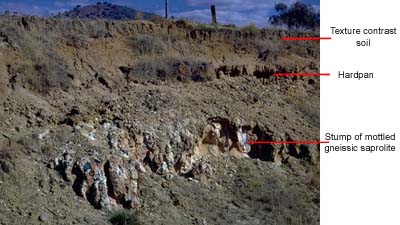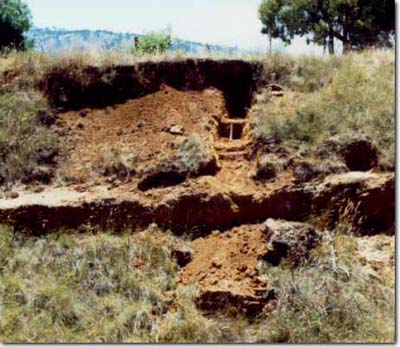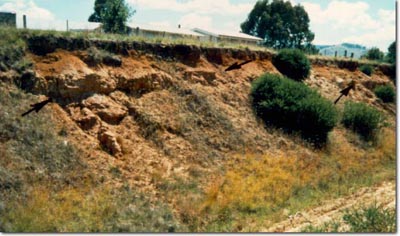Tallangatta Railway Cutting
The Tallangatta railway cutting (Site No. 2) is crossed by the road bridge at the western approach to the town of Tallangatta and exposes a large, complex alluvial-colluvial fan. The fan is part of the piedmont surface which appears to grade to cemented Pliocene river gravels (O’Shea 1979) at about 190 m elevation, on the Lake Hume foreshore at Tallangatta (Site No. 4). This suggests a possible Pliocene age for the land-surface which controls the fan gradient.
 Figure 3: Stratigraphy of the southern side of the Tallangatta fan railway cutting. |
At the eastern end of the southern side of the cutting (Figure 3), a stump of well-weathered gneiss with coarse orange-red and pale grey to white mottles is exposed (Photo 4). Overlying the gneiss is coarse colluvium-alluvium, grading up to finer gravelly sediments in which the hardpan has formed. The hardpan extends westward until interrupted by a deep, broadly U-shaped bed of expansive clay (coefficient of linear expansion 9%) which has a coarse, strongly contrasting pale grey mottle in an orange-red groundmass (Figure 3). This disruption of the stratified sediments in the exposure may have been the result of a subsequent gully cut and fill. Failure of a hardpan to develop in that material may have been due to the expansive nature of the clay which disrupted the consolidation process (Jha and Cline 1963). The hardpan continues to the west of this apparent insert in the fan sequence. At first indurating sandy sediments are found and then finer material, as it dips gently below a younger alluvial terrace mapped as the Pliocene-Pleistocene age Shepparton Formation (O’Shea 1979).
 Photo 4: Railway Cutting in the Tallangatta Fan. |
In the northern side of the Tallangatta cutting, the hardpan is well developed in medium textured sediments (Photo 2, Photo 3). In some places the hardpan overlies strongly coloured red-brown consolidated sandy sediments with very contrasting pale grey bleaching along what appear to be palaeo-biochannels.
 Photo 2: Tallangatta Hardpan in the Tallangatta railway cutting. The hardpan is about 2.5 m below the surface and up to one metre thick at this site. Detached blocks of hardpan lie on the slope below the hardpan layer. | |
 Photo 3: The northern side of the Tallangatta railway cutting which cuts through a thick alluvial fan on the valley piedmont. A pedogenic hardpan called the Tallangatta Hardpan extends along the cutting at a depth of about 1.5 m (see arrows). |
 Photo 5: Tallangatta Hardpan formed in strongly mottled sediments. |


